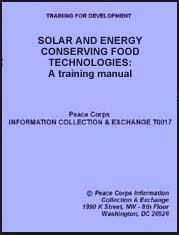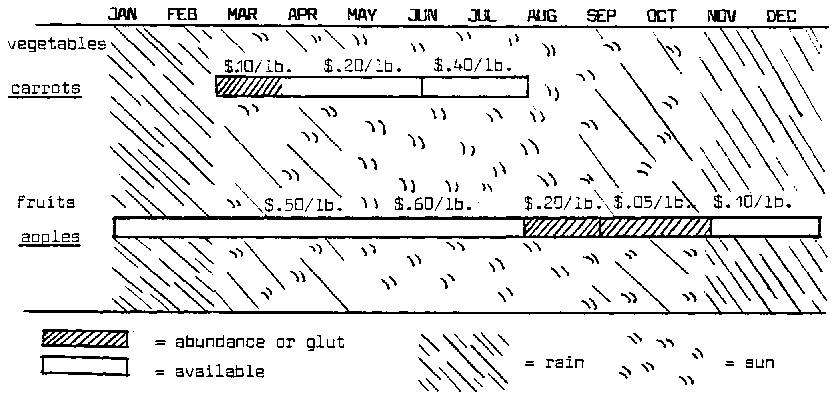
- (Peace Corps, 1984, 175 p.)
Looking at your community: the potential for solar food drying[edit | edit source]
OVERVIEW AND GOALS:
Before introducing any new technology, it is important to examine local conditions, customs and practices that determine the appropriateness of the innovation. In this session, the participants examine current methods of food preservation and storage, climatic conditions and the availability and price fluctuation of foods in their communities. By using this information it is possible to assess the feasibility of using solar drying as a method of food preservation in the participants' own communities.
OBJECTIVES:
To identify food preservation and storage methods currently used in the participants' communities
To identify useful data on local weather patterns
To look at the availability and price fluctuations of commonly used fresh foods throughout the year
To use information about the participants' communities to help determine the feasibility of solar food drying technologies
RESOURCES:
Improved Food Drying and Storage Manual, Session 4
Questionnaires included in Letters to Participants (Appendix D) for information on local conditions and food preservation and storage practices in their communities.
A large sample graph to show weather patterns, price fluctuations and food availability throughout the year (based on Handout 2A).
HANDOUTS:
Examining the Factors of Leather Patterns, Food Availability and Price Fluctuations (Handout 2A)
A Look at the Potential for Solar Drying in a Community (Handout 2B)
MATERIALS:
Newsprint and markers
PREPARATION: (Optional)
Draw a graph or other illustration on newsprint as an example for the participants to use as they describe the climatic conditions; availability and price fluctuations of fresh food in their communities. (A sample is attached in Handout A). You may want to draw the graph as it relates to your own community.
PROCEDURES AND ACTIVITIES:
- (10 minutes) Introduction and Warm-up Activity
Review the objectives for the session. Go around the circle of participants, and ask each person to name a favorite fruit or vegetable that is eaten in their community. As the fruits and vegetables are named, make a list of them on newsprint. Explain that the list will be the basis for the next activity, which will focus on the potential for drying fresh foods commonly eaten in the participants' communities.
- (45 minutes) food Availability, Price Fluctuation and Weather Patterns
Describe the activity: In order to help determine whether (and if so, when) solar food drying is feasible in the participants' communities, it is useful to look at data on the availability and cost of food at different times of the year, as well as the climatic conditions that exist in a particular region. One way of analyzing that information is to look at it graphically.
Show an example of a graph or chart based on data from a chosen region, and discuss the information represented.
Have the participants form groups according to region or community, and draw a large graph which represents the three factors throughout the year. (See Handout 2A for guidelines). As they complete the drawing, ask them to consider the following questions and information:
- What problems are there in your region or community relating to nutrition, health, crop loss and food waste?
- What methods of food preservation are currently used? Are any of the foods on the graph currently preserved? If so, how? What are same of the advantages and disadvantages of these methods?
- What does the graph tell us about the potential for using solar drying as a method of food preservation? (Remember that it is important to have at least 4 hours of sunlight a day, unless you will use a back-up system).
- What time of year is best to dry food in your region?
- Which foods are likely to be the ones that can be dried? Why?
- (45 minutes) Discussion
When the large group reassembles, ask each group to post their graph and have a group member describe the information they have recorded and analyzed.
Guide a discussion about the questions and considerations examined during the small group activity in Step 2. Look at the list of fruits and vegetables, and see which ones are available for drying during the course.
- (20 minutes) Summary and Transition to the Community Assessment (Session 3)
Discuss: How can we use the information we now have to design solar dryers? Have your ideas or perceptions changed about the possibility of solar drying in your community or region?
What are some factors we should examine before determining whether solar food drying is an appropriate technology in a particular community?
How can we find out the information we need?
How can solar drying help alleviate problems of health, crop loss and food waste in your community?
Distribute Handout 28 for the participants to use both during the next session (Identifying Community Needs and Resources) and in their own communities.
Examining the factors of weather patterns, food availability and price fluctuations
To make a graph:
- List 3-4 each of the most commonly eaten fruits and vegetables on the left side of the graph.
2. List the months of the year across the top.
3. Show what the weather is like for each month: Is it rainy most of the time? Is there intermittent rain and sun? Is it sunny almost every day? Is there no rain at all?
4. Show the availability and the price of the different foods during various times of the year: is there a glut? abundance? available, but expensive? not available at any price?
Use the drawing below to help you, or make your own graphic.
Figure
Some information this graph gives us is:
- The wet season is during January, February, November and December.
2. There is intermittent sun and rain during March, April, Sept. and Oct.
3. There is a lot of sun from May through Aug.
4. Carrots are cheapest in March; available, but mare expensive until August.
5. Apples are plentiful in August through October.
6. A good time to dry carrots would be starting in March; carrots from Aug. through Oct.
7. Solar drying with a back-up system would be a possibility in Aug. through October for apples.
A LOOK AT THE POTENTIAL FOR SOLAR DRYING IN A COMMUNITY
Use these questions to help you determine whether solar drying is an appropriate technology for a community:
- What foods are commonly dried?
2. What time of year does drying take place for each food?
3. How long does it take for each food to dry under sunny conditions? Cloudy conditions?
4. What problems are there with the traditional methods of drying?
5. What are the local tests for dryness?
6. How is each food stored when dry?
7. How long does each food last in storage? a. Are there problems encountered with storage of dried food?
9. Are there problems related to nutrition in the community? Specify.
10. Are there problems of food waste during times of abundance? Specify.
Other questions?
